

STEM EXPLORATION
Playful Experiments, Powerful Ideas Activity Book


Get access to animated learning videos, interactive quizzes, projects and more — all on the Uolo Learn app!

Download now & make learning fun!
STEM EXPLORATION
Activity Book

Acknowledgements
Academic Authors: Binny Singhal, Diksha Sharma
Design & Production: Satish, Mangal Singh Rana, Wajahat Khan, Sneha Sharma, Vishesh Agarwal
Project Lead: Bhavna Tripathi
VP, Learning: Abhishek Bhatnagar
All products and brand names used in this book are trademarks, registered trademarks or trade names of their respective owners.
© Uolo EdTech Private Limited
First edition 2026
This book is sold subject to the condition that it shall not by way of trade or otherwise, be lent, resold, hired out, or otherwise circulated without the publisher’s prior written consent in any form of binding or cover other than that in which it is published and without a similar condition including this condition being imposed on the subsequent purchaser and without limiting the rights under copyright reserved above, no part of this publication may be reproduced, stored in or introduced into a retrieval system, or transmitted in any form or by any means, electronic, mechanical, photocopying, recording or otherwise, without the prior written permission of both the copyright owner and the above-mentioned publisher of this book.
Book Title: STEM Exploration 4
ISBN: 978-93-49697-35-5
Published by Uolo EdTech Private Limited
Corporate Office Address:
91Springboard, 3rd Floor
145, Sector 44, Gurugram, Haryana 122003
CIN: U74999DL2017PTC322986
Printed by: Printpro Solutions
Illustrations and images: www.shutterstock.com, www.stock.adobe.com and www.freepik.com
All suggested use of the internet should be under adult supervision.
Preface
In today’s dynamic world, nurturing curiosity, critical thinking and creativity in learners is essential for preparing them to be the innovators and problem-solvers of tomorrow. STEAM education—integrating Science, Technology, Engineering, Arts and Mathematics—offers a holistic and experiential approach to support this endeavour. By encouraging learners to ask questions, make predictions and experiment, STEAM transforms learning into a joyful process of exploration and discovery while building essential life skills such as problem-solving, analytical thinking and collaboration.
At Uolo, we recognise the transformative potential of STEAM learning. The Uolo STEM Exploration series is based on the vision of the National Education Policy (NEP) 2020 and the National Curriculum Framework (NCF) 2022–23 , reflecting the shift from rote memorisation to experiential, multidisciplinary and competency-based learning. By making learning joyful, discovery-driven and rooted in real-life contexts, the series encourages inquisitiveness, creativity and the spirit of teamwork to enable learners to explore scientific and mathematical concepts in visual and creative ways. Through interdisciplinary connections, the use of accessible materials and a focus on real-world applications, it ensures that the learning remains inclusive, meaningful and lasting.
In line with global perspectives, STEAM is recognised as a pathway to nurture innovation and adaptability while contributing to the United Nations Sustainable Development Goals (SDGs). The STEM Exploration series embraces this global mission, ensuring that learners are prepared to contribute to a sustainable and equitable future.
The STEM Exploration series features age-appropriate, visually engaging and well-structured activities that integrate one or more disciplines of Science, Technology, Engineering, Arts and Mathematics. The book has been thoughtfully designed to spark curiosity and foster inquiry-driven learning through hands-on experiences that connect core concepts with the real world. Each activity inspires learners to observe, test and reflect, giving them the ability to think critically and apply their learning to every day situations.
To further enrich the learning experience, the series comes with digital content, provided free of cost, to ensure a seamless and holistic learning experience for learners. This content is accessible through QR codes, offering live demonstrations of activities for visual and self-paced learning. Together, these components nurture a dynamic learning journey that connects knowledge with skills, preparing children to innovate and thrive.
Uolo is accredited by STEM.org, one of the world’s leading STEM education research and credentialing organisations. This recognition validates the quality, authenticity and impact of our educational offerings. The content has been reviewed and approved by STEM.org’s rigorous standards, underscoring our commitment to delivering globally benchmarked educational resources.
By integrating artistic expression with scientific exploration, the STEM Exploration series nurtures learners to be inquisitive, confident and competent—ready to question, innovate and contribute meaningfully as global citizens.
We extend our warmest wishes to educators, parents and learners as they embark on this journey of discovery and innovation. Together, let us make learning an adventure that sparks imagination and inspires lifelong curiosity.
Key features of the book
Hands-on and Inquiry-Based Learning
The STEM Exploration series sparks curiosity through hands-on, inquiry-led activities that align with the NEP 2020. Children observe, question, explore and solve, thereby, building scientific temper, creativity and problem-solving skills.


STEAM Alignment
The activities in the book integrate Science, Technology, Engineering, Arts and Mathematics, encouraging interdisciplinary connections.
Visually Engaging and Fun
The book features vivid colours and lively illustrations to engage learners. A real-life image is provided at the end of each activity, helping learners connect concepts with practical outcomes.
Easy-to-Access Resources
All experiments are safe, age-appropriate and use low-cost and easily available materials, with clear step-by-step instructions for easy execution.

Critical and Creative Thinking
The activities encourage ‘learning by doing’. The Science Behind It section includes simplified explanations of the underlying principle while the Find Out More section offers extension activities for deeper exploration.

Real-World Connections
Experiments and worksheets connect learning to daily life and local contexts, making it practical and meaningful. The Real-Life Connect highlights direct applications of the concepts, showing learners how classroom concepts are relevant in the world around them.

Digitally Powered and Application-Based
Each activity is followed by a fun, application-based worksheet that helps learners revise and reinforce the key concepts. QR codes provide experiment videos for better clarity and self-paced learning.
Each activity in this book is thoughtfully designed to integrate the domains of STEAM — Science, Technology,
Arts and Mathematics. The table illustrates how activities align with one or more STEAM areas, ensuring that learning is interdisciplinary, engaging and competency-driven, in line with the NEP 2020 and NCF 2022 –23.
Smart ScIentIfIc TIps Before You ExperIment

Gather Your Materials First
Before you begin, collect everything you need for the experiment. Having your materials ready saves time and keeps the process smooth.
Ask Questions Often
Good scientists are curious. Don’t just follow the steps — stop and ask ‘Why did this happen?’ or ‘How does this work?’ The more questions you ask, the deeper your understanding will be.



Take Your Questions Further
Use each experiment as a starting point. If something surprises you, try it again with a change. New questions lead to new experiments, and that’s how real discoveries happen!
Failure Is Part of Science
Not every experiment works the first time, and that’s okay. Instead of feeling discouraged, think about what might have gone wrong and what you can adjust. Failure often teaches you more than success.
Make a Journal
Maintain a journal for all your experiments. Record observations, results, sketches and reflections. Journalling helps organise your thoughts, track progress over time and sparks ideas for future experiments.
Have Fun and Stay Curious
Science and experimentation is all about enjoying the process of discovery. Even small results can be exciting if you pay attention. Look for the ‘Aha!’ moments and celebrate them.


Walkthrough of Key Elements
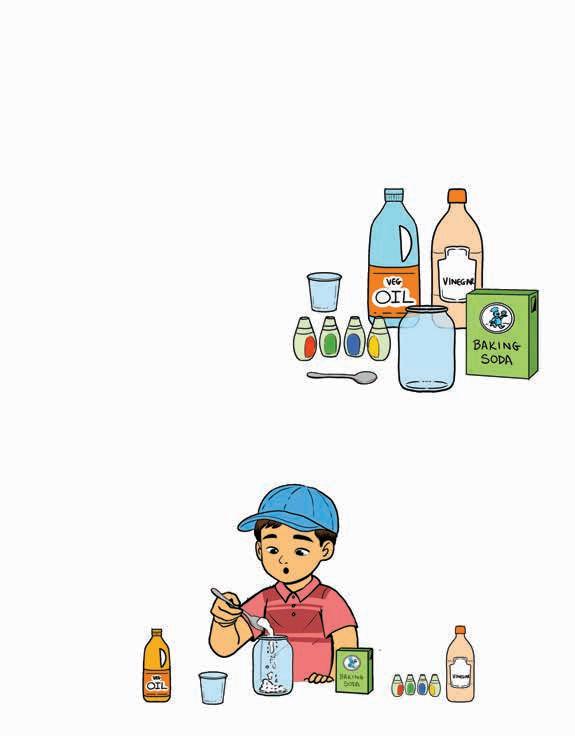
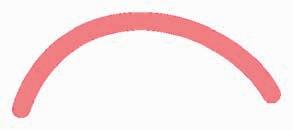















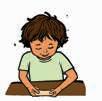
ScIence BehInd It...
Mixing corn flour and soap creates a
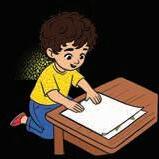

REFRESHING Jelly DrInk
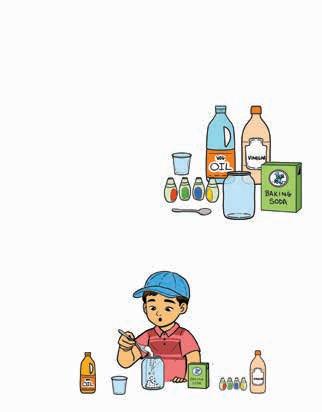



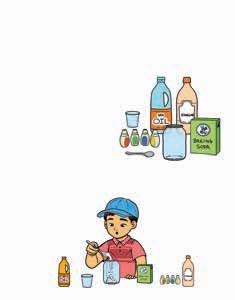





























Watch closely as the yellow liquid changes to a reddish-orange colour. 4.
Activity in Action
ScIence BehInd It...
Turmeric contains a natural pigment called curcumin, which changes colour when it mixes with certain substances. Soap is one of them. When added, the yellow colour turns reddish-orange.


Find Out More!
Try adding a little lemon juice to the same mixture. Watch how the colour changes back to yellow.
Check your learnIng!
1.
Arpit spilt some curry on his white shirt during lunch. The curry had a yellow spice in it. When his mother washed the stain with soap, the yellow colour turned reddish-orange. Answer the questions below on the basis of above reading.
A.
Which spice in the curry caused this colour change?

B. (a) (b) (c) (d)


What change in colour did Arpit observe?
Yellow Reddish-orange
Reddish-orange Yellow
Yellow Green
Yellow Purple

C. Use the picture clues to unscramble the letters and write the correct word.




2. State True/False.
Drinking turmeric milk can help us stay strong and healthy.


RETICMUR
OSAP
NIAST
RRYCU








Blow on the pinwheel and watch it spin. 6.
ScIence BehInd It...
When you blow on the pinwheel, the moving air pushes against the slanted blades. As the blades are turned in the same direction, the air pushes them around in a circle, making the pinwheel spin. This shows that moving air has force and can make things move.
Activity in Action

Find Out More!
Make pinwheels of different sizes. Blow with the same strength and see which one spins faster and longer.
1. Colour ( ) the pinwheel as shown in the picture.
2. State True/False.
A wind turbine uses wind energy to pump water and make electricity.


LAVA LAMP


What We Need
A glass jar
A spoon
A cup
Vegetable oil
Vinegar
Baking soda
Liquid food colour
Let’s B

Add 2 tablespoons of baking soda to the jar. 1.

2.
Pour in vegetable oil until the jar is about three-quarters full.
3.
In a small cup, mix vinegar with a few drops of food colour.
Now, pour the coloured vinegar into the jar. 4.
Pour it slowly to avoid spills. Watch out




5.
Watch the colourful bubbles rise. Add more vinegar if the bubbling stops to continue the fun.
ScIence B
When vinegar mixes with baking soda, it makes a gas called carbon dioxide. This gas gets trapped inside the colourful droplets of vinegar, making them lighter and lifting them up through the oil. Since oil and vinegar do not mix, the droplets sink back down once the gas bubbles escape, making them move up and down.

Find O
Use a torch or lamp behind the jar to make the colourful bubbles glow like a real lava lamp.

Check your learnIng!
1. Think and write.
I am the gas that makes soda fizz and bubbles rise, Invisible in the air, but see me in the surprise. From cans and bottles, I escape with a pop What am I that makes drinks hop?
2. Tick ( ) the correct answer.
A.
In the lava lamp activity, the movement of coloured blobs is caused by
(a) water bubbles
(b) gas bubbles
(c) oil bubbles


B. Which of these is NOT needed to make the lava lamp experiment work?
3. State True/False.
A. B. C. Oil is heavier than vinegar, so it sinks to the bottom of the jar.
The coloured vinegar blobs rise because the gas bubbles make them lighter.
Food colouring is added to make the vinegar more visible.


Flame Test
In this activity, we will learn that a candle needs oxygen to keep burning.
What We Need
A candle
A matchbox
A glass
A plate or tray

Let’s Begin
Ask an adult to light the candle.

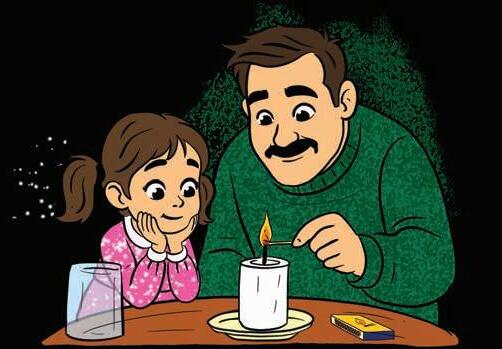
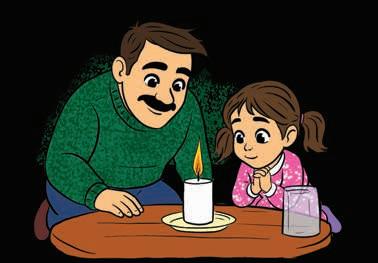
3.
Gently place a transparent glass upside down over the candle.
Do not touch the hot glass or the melted wax. Watch out
2.
Observe the candle flame as it burns brightly.

Real-lIfe Connect
Firefighters wear oxygen masks because fire uses up the oxygen around them, making it hard to breathe. The mask provides them with clean air so they stay safe while fighting fires.

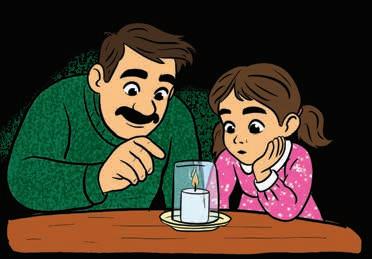
4.
Watch the flame carefully as it slowly gets smaller.

Note the time it takes for the flame to finally go out.

Activity in Action
ScIence BehInd It...
A candle needs oxygen to keep burning. When we cover it with a glass, the oxygen inside gets used up quickly. Without oxygen, the flame cannot burn and goes out.
Find Out More!
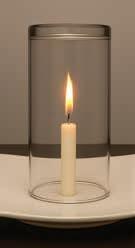

Test with glasses of different sizes and see if the candle goes out faster or slower.
Check your learnIng!
1.
Tick ( ) the correct answer.
Rekha lights a candle and then covers it with a glass jar as shown in the pictures A, B, and C. After a few seconds, the flame goes out.
A.
Why does the candle flame go out when covered with a glass jar?
The wax has melted away. (a) (b) (c)
The oxygen inside is used up.
The wick gets completely burnt.
B. Stage A Stage B Stage C (a) (b) (c)
C.
At which stage in the picture (A, B, or C) is the oxygen completely used up?
What did Rekha learn from this experiment?
Fire needs water to keep burning.
Fire needs air to keep burning.
Fire can burn without air or water. (a) (b) (c)
2. Fill in the blanks.
A.
We need _________ (oxygen/water) to breathe.
B.
In space, there is no air so things (can/cannot) _________ burn.
C.
You should never light a fire in a closed room because the fire uses up oxygen and fills the room with _________ (smoke/dust).
3. State True/False.
A candle covered with a bigger glass burns longer when compared to a smaller glass because it has more air inside.





Ask a friend to gently tap the spoon with a ruler.




Hold
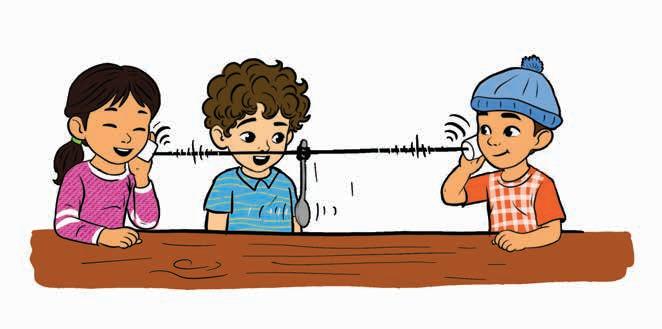
Activity in Action

Find Out More!
ScIence BehInd It...
Sound needs a medium to travel. When the spoon is tapped with a ruler, it vibrates. These vibrations travel along the string to the cup and reach the ears, where the brain interprets them as sound.
Try strings of different lengths. Does the sound change when the string is short or long?
Check your learnIng!
1. Think and write.
I am loud when the drum beats strong, Soft when you whisper a gentle song. I rise up high, or fall down low, But no matter the pace, I always flow. What am I?
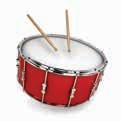
2.
Tick ( ) the objects that only make sound when we blow air into them.

3. State True/False.
Sound needs a medium to travel.
The string acts as a medium to carry vibrations from the spoon to the cup.
The cup in the experiment generates the sound.
The louder the tap on the spoon, the stronger the vibrations.
The brain interprets the vibrations reaching the ear as sound.


Colourful LIquId Tower
In this activity, we will learn how different liquids form layers when placed together in one container.
What We Need
1 glass
1 bowl
1 spoon
1 paintbrush
Honey
Vegetable oil
Blue watercolour
Water
Let’s Begin
1.
Gently pour honey into the glass.


2.

3.
Pour the water slowly on top of the honey.

In a small bowl, mix water with blue watercolour.

Pour liquids gently along the side of the glass to prevent spills. Watch out
4.
Now pour vegetable oil on top of the water.

Watch all three liquids settle into different layers. 5.
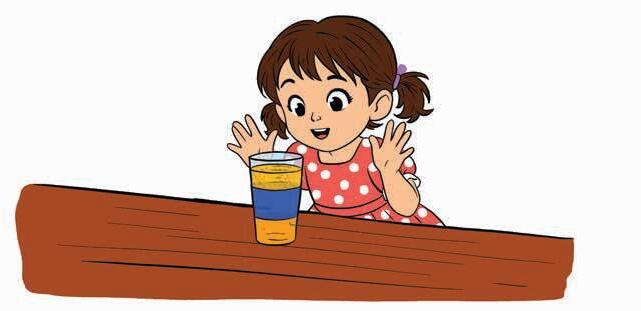
Activity in Action
ScIence BehInd It...
Some liquids are heavy and some are light. Honey is the heaviest and settles at the bottom. Water is lighter than honey but heavier than oil, so it stays in the middle. Oil being the lightest, floats on the top.
Find Out More!

Drop a coin and a plastic bottle cap into the layered liquids. Observe in which layer each one stops and think about why it happens.
Check your learnIng!
1. Think and write.
I live in your kitchen but don’t like to blend. Mix me with water—we won’t stay friends. Shake me around, I’ll spin for a while, Then float back up with a sunny smile. What am I?
2.

Look at the two jars shown in the picture. Label the liquids in each jar using the words given below.
3.
Meera helped her mother make a salad. When they poured oil and vinegar into a bowl, they seemed mixed, but after a little while, the oil slowly moved up and the vinegar stayed down.
A. What did Meera notice about the oil and vinegar?
They made two separate layers. They turned into a thick paste. (a) (b)
B. Why did the oil rise to the top?
Oil is lighter than vinegar. Oil is heavier than vinegar. (a) (b)
C. If Meera stirs the bowl quickly, what will happen?
The liquids will mix for a while but separate again. The vinegar will turn into oil after mixing. (a) (b)



Let’s Begin S Limonene in orange peel makes the balloon pop
Pop wIth a PEEL
In this fun activity, we will see how an orange peel can make a balloon pop.
• 1 balloon • Orange peel What We Need

1. Take a balloon and blow it up. Tie a knot so the air doesn’t escape.



2. Hold a piece of orange peel close to the balloon.

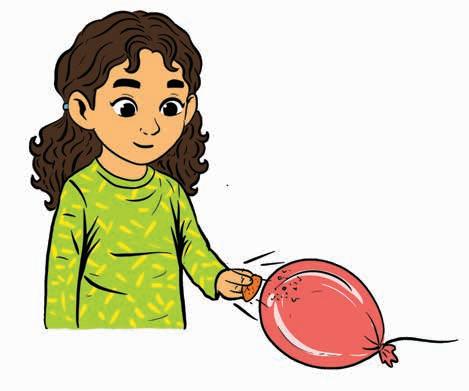
Watch out
Keep your face and eyes away while popping the balloon.
Squeeze the peel to spray its juice onto the balloon.

4. Watch the balloon suddenly burst with a loud pop.

Activity in Action
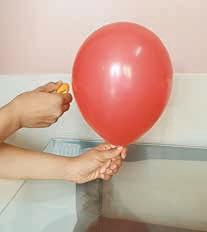
Find Out More!
ScIence BehInd It...
Orange peel contains a substance called limonene. When the limonene comes into contact with the balloon, it weakens the latex (rubber), causing it to pop.

Try popping balloons with lemon, lime or grapefruit peels. Which peel makes the balloon pop the fastest?
Check your learnIng!
1.
Unscramble the letters to form a word.
(a) A substance in orange peel
M L I N O E N E →
(b) What we blow up
L O B A N O L →
(c) The fruit used in the activity
G O A N R E →
2.
Tick ( ) the fruits whose peel can pop a balloon.
Hint: Look for citrus fruits.




3. State True/False.
(a) Orange peels contain a special substance that can make balloons pop.
(b) Apple peel can pop a balloon just like an orange peel.
(c) Limo nene is also found in the peel of citrus fruits like lemon and grapefruit.
(d) A banana is a citrus fruit.




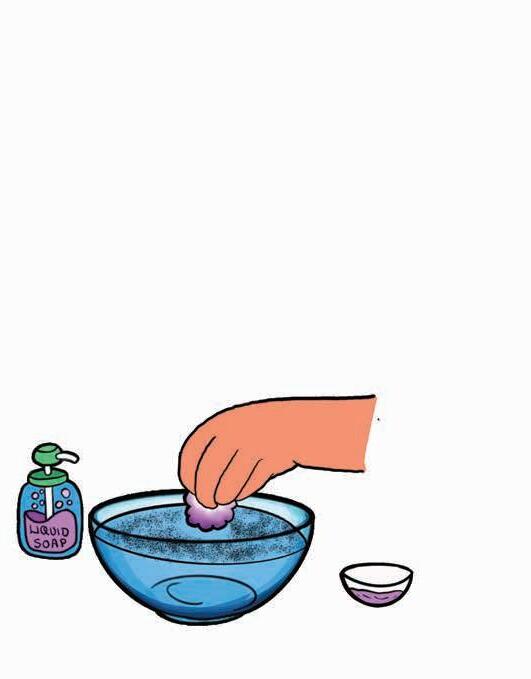


Ind It...
Water forms a thin layer floats on it, but adding
move to the sides of the
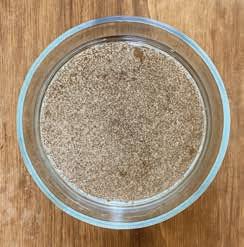

Sprinkle pepper on water and touch a soapy cotton ball to the edge of
Check your learnIng!
1. Unscramble the letters to form a word.
SPAO: A.
This is the substance that breaks the surface of the water.
TWERA: B.
This is the liquid that holds the pepper on its surface.
2. Tick ( ) the correct answer.
What will happen if we touch the pepper and water with a clean cotton ball (without soap)?
Pepper will move to the sides.
Pepper will sink to the bottom. (a) (b) (c)
Pepper will float in the same way as before.
3. Fill in the blanks.
Pepper ______ (floats/sinks) in water.
When we add soap, it _______ (breaks/forms) the surface of the water.
When we add soap, the pepper _______ (moves/stays) to the sides.
4. State True/False.
Water helps insects like water striders walk on it without sinking because the water's surface layer holds them up.


Balloon Shooter
In this activity, we will find out how stretching a balloon and letting it go can create enough force to make a cotton ball fly.

What We Need
1 paper cup 1 balloon Cotton balls A pair of scissors Tape


Begin



Ask an adult to make a small cut at the bottom (round) part of the balloon. 3.

Stretch the cut part of the balloon over the bottom of the cup. 4.
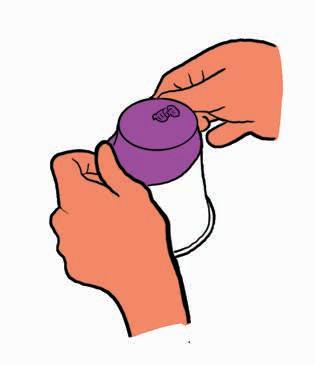
Tape the balloon tightly to the cup.
Put a small cotton ball inside the cup. 6.
Use only soft items to prevent injury. Watch out


7.
Pull the balloon knot back like a slingshot.
8.
Let go of the knot and watch the cotton ball fly out.

Activity in Action


ScIence BehInd It...
When you pull back the knot of the balloon, it stores energy. When you let it go, this stored energy changes into motion which pushes the cotton ball forward through the air.
Find Out More!
First, pull the balloon knot a little and let the cotton ball go. Then, pull it back farther and release it. Does the cotton ball travel different distances each time?
Check your learnIng!
1. Think and write.
I am not alive, but I make things move, A push or a pull is how I groove. You’ll find me in every jump and throw. What am I?
2. State True/False.
3.
C.
Pulling the band of a slingshot does not use any force. A. B.
When we pull back and release a bow, the stored energy changes into motion.
The farther you pull the balloon, the more energy is stored and the faster the cotton ball moves.

Look at this toy car with its key wound up. Draw an arrow to show the direction it will move when the key is released.

Scrub and play putty
In this activity, we will make a soft and squishy putty that is fun to play with and can also be used as a bar of soap.


What We Need

Let’s Begin

Add 2 tablespoons of dish soap to it.

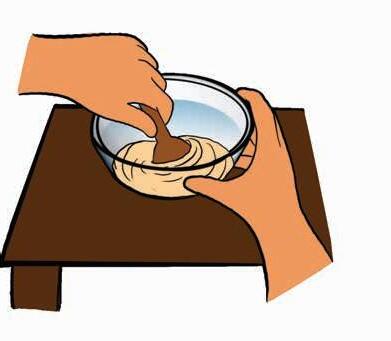
Mix the mixture until it starts to thicken.
If the dough does not stretch, add a few extra drops of dish soap. Watch out
Knead the dough with your hands until it becomes soft


Your super scrub putty is ready. Have fun playing and shaping it. You can even use it to clean your hands..

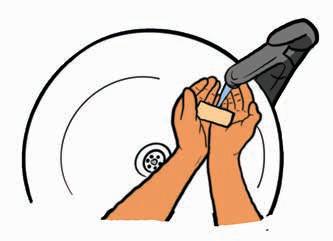
Activity in Action
ScIence BehInd It...
Mixing corn flour and soap creates a soft and squishy dough. The corn flour thickens the mixture while the soap makes it stretchy like clay. Even though it looks and feels different, the ingredients keep their original properties—the soap can still clean and the corn flour gives it shape.
Find Out More!

Add a few drops of food colouring to your scrub putty and knead it well to make it attractive to play and wash with.
Check your learnIng!
1.
Roshni mixed corn flour and liquid soap in a bowl. It turned into a soft, squishy putty that felt like clay. She found it was perfect for playing and cleaning at the same time.

Soap Corn flour (a) (b)
B. Why is this putty better for playing than plastic toys? It is slippery and feels softer. It can be reshaped and reused. (a) (b)
C. How should Roshni store the putty to make it last longer?
Store it in an open container. (a) (b)
Store it in a sealed container.
2. State True/False.
A. A. B.
C. D. What makes the putty soft and squishy?
The scrub putty can be stretched like clay.
Adding too much soap can make the putty too soft or runny.
The putty can be used for cleaning as well as playing.
Adding corn flour makes the putty safe to eat.

Straw brIdge
In this activity, we will make a strong bridge using straws that can hold weight.
What We Need
Tape
A pair of scissors
16 straws
2 books of equal height
Small objects (like erasers, coins, buttons)

Let’s Begin


Place 10 straws side by side. Tape them together to form a flat base. 1.
2.
Cut 6 straws equal to the width of the base and split them into two groups of 3 straws each.
Ask an adult to cut the straws for you. Watch out


Tape one set of straws near one end of the base and the other set near the other end of the base. 3.
Real-lIfe Connect

Place this straw bridge across two books with its 4.
Just like your straw bridge holds small things, real bridges are made to carry cars, buses, and trains safely.


Place small objects like an eraser or coin in the centre of the bridge to see how much weight it can hold.

Activity in Action
ScIence BehInd It...
Taping straws together makes the bridge stronger by sharing the weight. Adding small straw pieces at the base increases its stability, helping it hold more weight without breaking.

Find Out More!
Try making straw bridges in different shapes like triangles, squares or arches and see which one holds the most weight.
Check your learnIng!
1. Tick ( ) the correct answer.
A. Why do we place coins or erasers on the bridge? (a) (b) To make it colourful To test its strength
B. What do the books used in this activity work as? (a) (b)
The base for the bridge to rest on The weight placed on the bridge
2. State True/False.
A bridge made of one straw can hold more weight than a bridge made of many straws.
The shape of the bridge can change how much weight it can hold.
C.
Adding support at the base helps the bridge stay balanced and makes it more stable.
3. Rohit needs to cross the river by walking over the bridges. Some bridges are broken and some are safe. Find a path that takes Ravi safely from START to GOAL.

MagIc Arrow FlIp


Let’s Begin S Light bends when it passes through different mediums T Using a glass of water and paper to observe the arrow flip A Drawing an arrow

In this activity, we will see how an arrow appears to flip when seen through a glass of water.
• A glass
• A white paper
• A marker
• Water What We Need

1. Draw two arrows pointing to the left on a piece of paper.

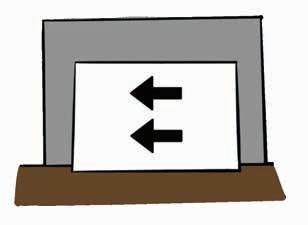
Stand the paper upright on the table using a support behind it.
3. Place an empty glass in front of the paper and look at the arrows through the glass.


Watch out
Be careful while handling the glass, as it can break easily.
Slowly fill the glass halfway with water.

5. Look through the glass, the arrow at the bottom now seems to point to the right!

Activity in Action

Find Out More!
ScIence BehInd It...
When light passes from one medium to another like from air into glass, then water, then back into air, it bends and changes direction. This bending of light changes the way our eyes see the arrow, making it appear to point in the opposite direction.

Draw numbers like 3 or 4 and look through a glass of water. Do they appear flipped?
Check your learnIng!
1.
2.
Draw what the numbers looks like after looking through full glass of water.
Tick ( ) the correct answer.
A. Sau mya draws an arrow pointing right on a sheet of paper and places a glass in front of it. She adds water to the glass and looks through it. Which way will the arrow point?
(a) Sam e as the original (points right)
(b) Opposite direction (points left)
(c) Points up
B. Why does the arrow appear flipped when seen through a glass of water?
(a) The light from the arrow moves straight without bending.
(b) The light bends as it passes through different mediums.
(c) The light makes the arrow move and change its direction.
3.
Fill in the blanks using the words given below. flipped change see different light
A. The arrow appears flipped because __________ bends when it passes through air, glass and water.
B. Lo oking at the arrow through a glass of water shows that light seems to __________ the direction of an object.
C. When light bends as it passes through water, it changes the way our eyes __________ the arrow.
D. When you look at the arrow through a glass, your eyes see it from a __________ angle.
E. The arrow does not actually move; it only looks __________.


VIsualIsIng Numbers wIth Beads
In this activity, we will use pencils and colourful paper beads to count numbers.
In this activity, we will understand and visualize numbers using colourful paper beads.
What We Need
3 pencils
Glue
Sketch pen
3 coloured sheets
A pair of scissors
A cardboard box

Let’s Begin

Take a cardboard box and mark three dots on it—one on the left, one on the right, and one in the middle. 1.

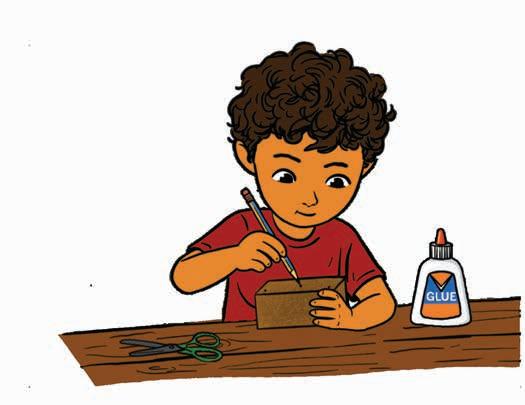
Push a pencil into each dot on the box. These will be the place value rods.

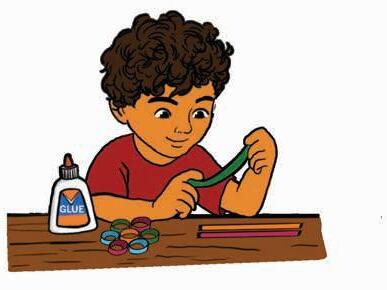
Cut small strips of coloured sheets. Roll each strip and glue the end to form round beads.
DId You Know?
The abacus is one of the oldest math tools, used over 2,000 years ago to count numbers and do
4.
Label the three pencils as Hundreds, Tens and Ones by taping strips to the box.


Make numbers by placing beads on the ‘Hundreds’, ‘Tens’ and ‘Ones’ pencils. For example, to make 113, put 1 bead on Hundreds, 1 bead on Tens, and 3 beads on Ones. You can add or remove beads to perform 5.

Activity in Action
ScIence BehInd It...
In this abacus, each pencil shows a different place value: the left pencil is hundreds, the middle is tens and the right is ones. It helps to visualise numbers, understand place value and do basic calculations.

Add a Thousand pencil rod to your abacus to visualise four-digit numbers.
1. Colour the beads of the abacus to show the numbers given below.
2. Cross out the beads on the abacus to match the number shown.
3. Draw beads on the abacus to show the given number.

REFRESHING Jelly DrInk
In this activity, we will make a refreshing drink by soaking dry pieces of Gond Katira, which swell and turn into soft jelly.
What We Need
1 lemon
1 glass
1 spoon
Sugar Salt
Black pepper
Gond Katira (A few small pieces)
Water
Let’s Begin
1.
Soak a few pieces of dry Gond Katira in a bowl of water overnight.

Watch out
Do not eat the Gond Katira before it swells; it is hard and can choke you.

Check the next day. The Gond Katira will swell up to become soft and jelly-like. 2.
Take a spoonful of the soft Gond Katira jelly and put it 3.


Squeeze half a lemon, then add 1–2 spoons of sugar, a pinch of salt and black pepper to the glass. 4.


Fill the glass with cold water and stir it well. 5.


ScIence BehInd It...
The hard Gond Katira pieces absorb water and swell into soft jelly. This jelly is mostly water, which helps keep our body cool and hydrated, especially on hot days.
Find Out More!
Enjoy your cool, refreshing and healthy drink.
DId You Know?
?
Gond Katira is a natural gum that comes from the sap of certain plants.
Activity in Action

Add a few mint leaves or a pinch of black salt to your Gond Katira drink. Take a small sip and see how the flavour changes.
Check your learnIng!
1.
Rearrange the letters to form a meaningful word.
2. Tick ( ) the correct answer.
A. It becomes smaller. It swells and becomes jelly-like. (a) (b)
What happens to Gond Katira when it is soaked in water?
B. It keeps our body cool and hydrated. It makes us feel sleepy. (a) (b)
Why is a Gond Katira drink good on hot days?
C. Water Sugar (a) (b)
What is the main ingredient in Gond Katira jelly?

3. Help the child find the way to the refreshing drink.
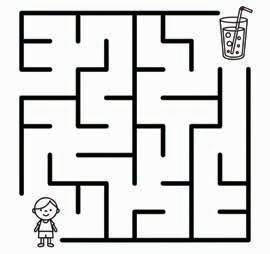

CD Hovercraft


What
In this activity, we will make a toy hovercraft to see how air can help it move smoothly across a flat surface. Let’s Begin




4.
3.
Stretch the balloon’s opening over the top of the bottle cap and wrap a tape around it.
Glue the cap firmly to the centre of the CD on the top side.
Make sure the bottle cap is fixed tightly to the CD to prevent air leaks. Watch out


Flip the CD over and blow air through the hole to inflate the balloon. Twist the neck to trap the air inside.
DId You Know?
Some military hovercrafts are as big as ships and can carry heavy loads, cars and people. They can glide smoothly over both water and land.

Place the CD on a smooth surface and release the balloon’s neck. Watch your hovercraft glide.

Activity in Action
ScIence BehInd It...
When air escapes from the deflating balloon through the hole in the cap, it spreads under the CD and creates a layer. This layer of air lifts the CD a little bit, reducing friction with the surface. With less friction, the CD can glide smoothly across the surface.

Find Out More!
Place your hovercraft on different surfaces like the floor, cardboard or a countertop. On which surface does it move the best?
Check your learnIng!
1.
Tick ( ) the correct answer.
A.
What makes the CD glide smoothly?
The weight of the CD.
The layer of air under the CD.
B. (a) (b)
What will happen if the cap is not fixed tightly to the CD?
The hovercraft glides faster than usual.
The air leaks and the hovercraft will not glide well.
C. (a) (b)
Why does the hovercraft glide farther on a smooth surface?
Smooth surfaces have less friction.
Smooth surfaces have more friction.
D. (a) (b)
What makes the balloon important in this activity?
It stores the air that creates the air cushion. It adds weight so the CD stays on the surface.
E. (a) (b) (c)
Karan’s hovercraft is moving very slowly. What could be the reason?
The balloon is not inflated enough.
The surface is rough and has more friction.
Both a and b are correct.
2. State True/False.
A. (a) (b)
A toy car moves faster on a carpet than on a smooth floor.
Some hovercrafts are large enough to carry cars and people while moving over water. B.




Wax ResIst Leaf PrInts
In this activity, we will see how wax resists colours and shows hidden leaf patterns.
What We Need
3-4 fresh leaves (different shapes and sizes)
Two white drawing sheets
A white candle A paintbrush Watercolours
Let’s Begin
1.
Place 3-4 fresh leaves on a drawing sheet with the back side facing up.

Do not use dry or brittle leaves. Watch out


Place another white sheet on top of the leaves and press gently.

Now, paint over the sheet with different watercolours. Wait for it to dry. 4.
Carefully rub the white candle on the sheet where the leaves are placed.

DId You Know?
3. ?
Honeybees make beeswax to build their honeycombs. Humans have been using this wax for art, candles and for protecting surfaces for thousands of years!


ScIence BehInd It...
Wax and water do not mix with each other. When we rub a candle on the sheet where the leaf is, that part gets covered with wax. When we paint, the colours stay on the sheet but slide off the wax. That is how the hidden leaf patterns appear clearly.
Find Out More!
Watch the colourful leaf patterns appear clearly.
Activity in Action
Try the activity with feathers, coins or other easily available items and make interesting patterns.

Check your learnIng!
Tick ( ) the correct answer.
A. (a)
Meena wanted to make colourful leaf patterns. She used a dry leaf, but when she painted over it, the leaf’s design did not appear clearly.
Why wasn't the leaf pattern clear?
The leaf was too dirty.
The leaf was too colourful.
The leaf was too dry and weak to hold the wax. i. ii. iii.
What should Meena do next time to get a clear leaf print? (b)
Use the same dry leaves i. ii. iii.
Use colourful paper leaves
Use fresh and soft leaves
B.
A drop of water falls on a wax candle. What will happen?
The water will soak in.
The water will roll off.
The water will change colour. (a) (b) (c)
Which of the following contains wax?

C.
(a)
(b)
(d) (c) Candle Crayon Chalk Cups

MInute tImer
In this activity, we will make a timer that lasts one minute using the flow of sand.
What We Need
• 1 spoon
• 2 bottles (same size)
• 2 bottle caps
• Dry sand or salt
• Funnel or paper cone
• Glue or tape
• Stopwatch or clock


1.


Ask an adult to make a hole in both caps and join them tightly with glue or tape.
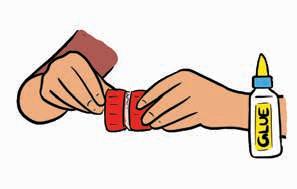
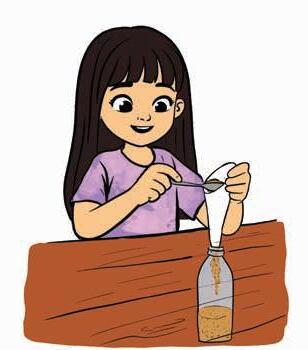
Fill one bottle halfway with dry sand or salt using a funnel or paper cone.
4. Attach the double cap to the filled bottle, then tighten the empty bottle onto the other side.


5. Turn the bottles upside down and use a stopwatch to check the sand flow time. Adjust the amount of sand until it takes one minute for it to pass through the hole. Your minute timer is ready.
Watch out
Do not shake the timer while sand is flowing.

Activity in Action
ScIence BehInd It...
A sand timer works because gravity pulls the tiny, dry grains of sand downward through a small hole at a steady rate. It can be used to measure short periods of time like one minute for games, activities or experiments.
Find out More!

Use your timer to measure one-minute tasks like jumping jacks, drawing or reading a page.
1.
Look at the pictures below. Tick ( ) the ones where you see things moving or falling because of gravity.





2. Tick ( ) the correct answer.
A. What flows inside a minute timer?
(a) Sand (b) Time
B. What controls the flow of sand in a minute timer?
(a) The size of the bottle
(b) The hole between the bottles
3. State True/False.
A. The sand flows upward because of gravity.
B. Wet sand works better than dry sand for a timer.
C. You can use the timer to practice one-minute tasks.
D. You can flip the timer to use it again.
E. The hole size does not affect how fast the sand flows.


CoIn DOME Challenge
In this activity, we will see how water drops stick together and form a tiny dome on a coin.
What We Need
A coin
A cup of water
A dropper

Let’s Begin
A plate Put a coin on a plate or table. 1.

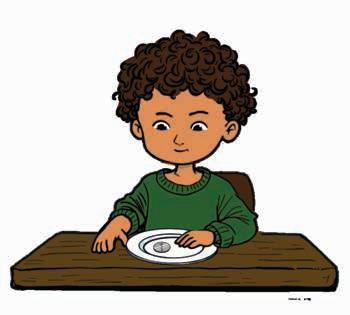
Use a dropper to take water from a cup. 2.

Hold the dropper just above the centre of the coin and gently squeeze out one drop at a time. 3.
Count how many drops fit on the coin before the water spills over. 4.

5.

Real-lIfe Connect

Raindrops look round on a leaf because the water molecules stick closely together.
Dry the coin with a paper towel and repeat the activity 2–3 times.
Watch out
Put each drop on top of the other drop very slowly so the water can form a dome.


Record how many drops the coin could hold each time in this table:
ScIence BehInd It...

Water is made of tiny particles that like to stick together. In a drop of water, the particles on the top get pulled inward by the ones below. This pull makes the drop form a little dome on the coin. The dome stays until it becomes too big and heavy, and then spills over. Find Out More!
Try

Check your learnIng!
1.
Tick ( ) the correct answer.
Nancy is trying the water drop experiment with different coins: ₹1, ₹5, and ₹20. She adds water drops on each coin and carefully counts how many drops fit before the water spills.
A. Which coin do you think will hold the most drops?


(a) ₹1 (c) ₹20 (b) ₹5
B. Which factor affects how many drops can fit on a coin?
(a) Size of the water drop
(b) Size of the coin
(c) Both a and b
C. What will happen if Riya will use a dirty or oily coin?
(a) The water drops will stick better and more drops can fit.
(b) The water drops may slide off and fewer drops can fit.
(c) Nothing will change.
2. State True/False.
Drops of dew look round on grass because water molecules stick together and pull on each other.



PaddleBoat

Secure the pencils firmly to the bottle using rubber bands at different places. 3.






Place your boat in a tub of water and release the stick, it will spin and push the boat forward!
Activity in Action

When you let go, the rubber pushes the water backward F
Try making boats with small, medium and large bottles to see how the size of the bottle affects how it floats and moves.
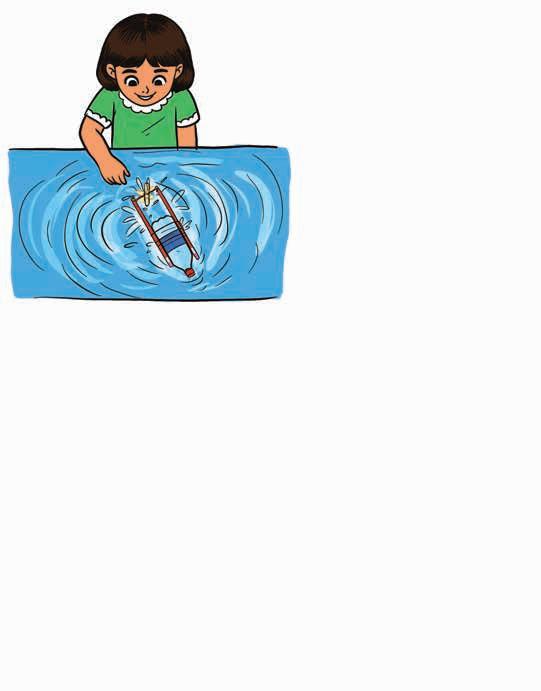

Check your learnIng!
1.
Tick ( ) the correct answer.
Tanya was practicing archery. She pulled back the string of her bow, held it for a moment and then released it. The arrow quickly shot forward and hit the target.
What happened when Riya pulled back the string of the bow? A.
The bow lost energy. (a) (b) (a) (b)
The bow stored energy.
Why did the arrow move forward when Riya released the string? B.
The stored energy in the bow is released causing the arrow to move forward.
The bow becomes lighter and pushes the arrow forward.
2. State True/False.
A catapult stores energy when it is pulled back and releases it to launch an object.
3. Fill in the blanks.

Twisting the rubber band stores ________ (energy/heat).
The spinning stick on the boat works like a ________ (paddle/wheel) that helps it move. A. B. C. D.
The boat moves because the spinning stick pushes the ________ (water/air) backward.
The rubber band boat shows how energy can cause ________ (movement/sound).
MYSTERY Straw Bottle
In this activity, we will find out how air pressure makes water move in and out of a straw.
What We Need
• A bottle
• A drinking straw
• Thick glue/clay
• Water

Let’s Begin
1. Ask an adult to make a small hole on the side of the bottle, a little above the bottom.

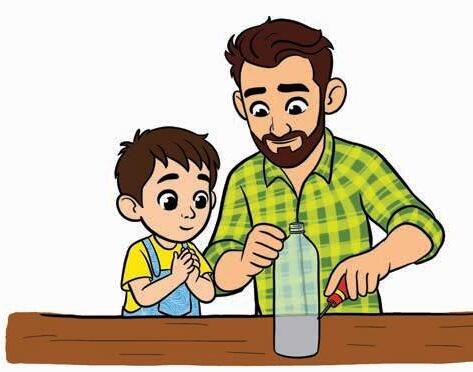

2. Push a straw into the hole so it points downwards.
3. Seal around the straw with thick glue or clay.
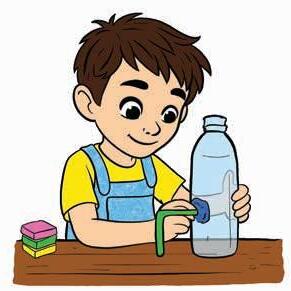

4. Cover the open end of the straw with your finger and fill the bottle with water.
Watch out
Make sure the seal is tight so no water can leak out.
5. Keep your finger on the straw and close the cap tightly. Place a bowl under the straw’s open end.
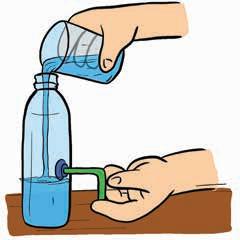

6. Lift your finger and loosen the cap a little. Watch the water flow into the bowl.

Real-lIfe Connect
When you sip through a straw, air pressure helps push the liquid up into your mouth.

7. Tighten the cap again and observe how the water flow stops.
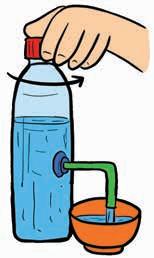
ScIence BehInd It...
Air takes up space and exerts a force on things. This force is called air pressure. When a bottle’s cap is closed, no air can enter, so the water stays inside. But when the cap is loosened, air enters and pushes the water out through the straw.
Activity in Action
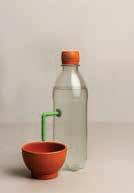

Find Out More!
Fill the bottle at different levels—half, three-quarters and full. Watch how the water flow changes with height.

Check your learnIng!
1.
Draw arrows to show the direction of the air and water flow in the given setup.
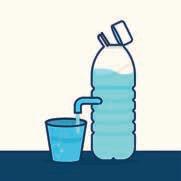
2.
Maya uses a dropper to take cough syrup. When she squeezes it, liquid comes out. When she releases it, the liquid goes inside.
Answer the questions below.
A. Why is Maya using a dropper instead of drinking the syrup directly from the bottle?
(a) To take the right amount of syrup
(b) To drink the syrup drop by drop
B. Which force is helping the liquid move?
(a) Air pressure
(b) Water pressure
3. Fill in the blanks.

A. When we ride a bicycle, the tires stay round and hard because of the (air/oil) pumped inside.
B. If the cap on a water bottle is tightly closed, water (cannot/ can) flow out through a straw easily.
C. When you sip through a straw, air pressure helps push the liquid (up/down) into your mouth.
Coloured sheet for activity on page 5
About the Book
STEM Exploration is thoughtfully designed to make learning a joyful journey of discovery through hands-on activities and real-world applications. Aligned with the NEP 2020 and the NCF 2022–23, it promotes experiential, multidisciplinary, and competency-based learning. By integrating Science, Technology, Engineering, Art and Mathematics (STEAM), it supports holistic development, builds essential 21st-century skills and empowers learners to contribute to a sustainable and equitable future in line with the UN Sustainable Development Goals (SDGs).
Key Features
• STEAM Alignment: Activities integrate Science, Technology, Engineering, Arts and Mathematics encouraging interdisciplinary connections
• Hands-on and Inquiry-Based Learning: Activities spark curiosity through exploration, observation and experimentation, helping learners develop scientific temper, creativity and problem-solving skills
• Digitally Powered: QR codes link to experiment videos for visual and self-paced learning
• Easy-to-Access Resources: Use of safe, low-cost and accessible materials with clear instructions for easy execution
• Real-World Connections: Activities and worksheets link concepts to daily life and local contexts ensuring meaningful and practical relevance
About Uolo
Uolo partners with K-12 schools to provide technology-enabled learning programs. We believe that pedagogy and technology must come together to deliver scalable learning experiences that generate measurable outcomes. Uolo is trusted by over 15,000+ schools across India, Southeast Asia and the Middle East.
ISBN 978-93-49697-35-5

